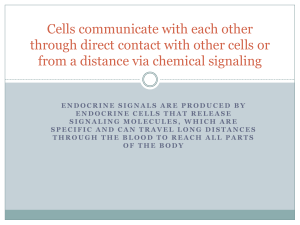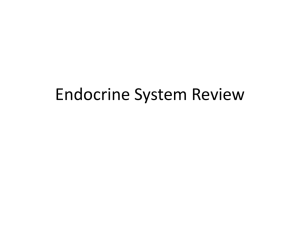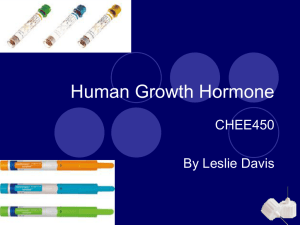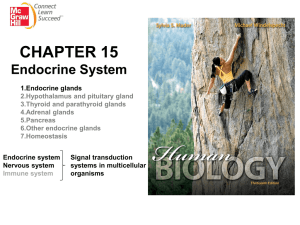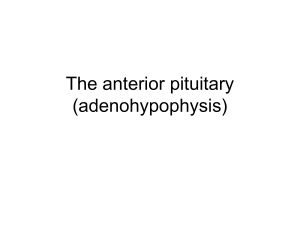CHAPTER SUMMARY
advertisement
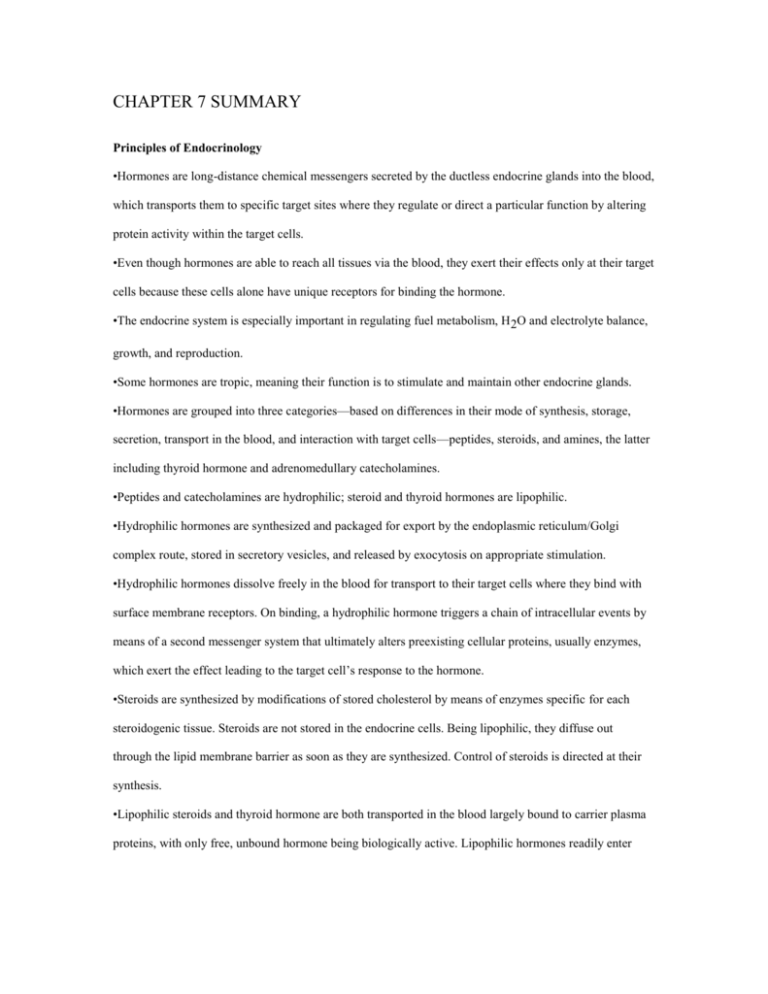
CHAPTER 7 SUMMARY Principles of Endocrinology •Hormones are long-distance chemical messengers secreted by the ductless endocrine glands into the blood, which transports them to specific target sites where they regulate or direct a particular function by altering protein activity within the target cells. •Even though hormones are able to reach all tissues via the blood, they exert their effects only at their target cells because these cells alone have unique receptors for binding the hormone. •The endocrine system is especially important in regulating fuel metabolism, H 2O and electrolyte balance, growth, and reproduction. •Some hormones are tropic, meaning their function is to stimulate and maintain other endocrine glands. •Hormones are grouped into three categories—based on differences in their mode of synthesis, storage, secretion, transport in the blood, and interaction with target cells—peptides, steroids, and amines, the latter including thyroid hormone and adrenomedullary catecholamines. •Peptides and catecholamines are hydrophilic; steroid and thyroid hormones are lipophilic. •Hydrophilic hormones are synthesized and packaged for export by the endoplasmic reticulum/Golgi complex route, stored in secretory vesicles, and released by exocytosis on appropriate stimulation. •Hydrophilic hormones dissolve freely in the blood for transport to their target cells where they bind with surface membrane receptors. On binding, a hydrophilic hormone triggers a chain of intracellular events by means of a second messenger system that ultimately alters preexisting cellular proteins, usually enzymes, which exert the effect leading to the target cell’s response to the hormone. •Steroids are synthesized by modifications of stored cholesterol by means of enzymes specific for each steroidogenic tissue. Steroids are not stored in the endocrine cells. Being lipophilic, they diffuse out through the lipid membrane barrier as soon as they are synthesized. Control of steroids is directed at their synthesis. •Lipophilic steroids and thyroid hormone are both transported in the blood largely bound to carrier plasma proteins, with only free, unbound hormone being biologically active. Lipophilic hormones readily enter through the lipid membrane barriers of their target cells and bind with nuclear receptors. Hormonal binding activates the synthesis of new intracellular proteins that carry out the hormone’s effect on the target cell. •The effective plasma concentration of each hormone is normally controlled by regulated changes in the rate of hormone secretion. Secretory output of endocrine cells is influenced by two different types of direct regulatory inputs: (1) neural input, which increases hormone secretion in response to a specific need and also governs diurnal variations in secretion; (2) input from another hormone, which involves either stimulatory input from a tropic hormone or inhibitory input from a target cell hormone in negativefeedback fashion. •The effective plasma concentration of a hormone can also be influenced by its rate of removal from the blood by metabolic inactivation and excretion, and for some hormones by its rate of activation or its extent of binding to plasma proteins. •Endocrine dysfunction arises when too much or too little of any particular hormone is secreted. Symptoms are generally referable to exaggerated or insufficient target cell responses normally controlled by the hormone. INVERTEBRATE ENDOCRINOLOGY •Hormones in invertebrates with circulatory systems regulate a variety of homeostatic, developmental and growth functions. Examples include regulation of egg-laying in molluscs and annelids, molting in arthropods, and metamorphosis in insects. •Molting is the cyclical pattern of replacement of the exoskeleton in arthropods that is essential for increasing body size as well as for any changes in body form. •Ecdysone and juvenile hormone (JH) are two of the regulatory hormones involved in larval development, molting and metamorphosis. •At the time of molt, neural signals trigger the release of PTTH, which then is transported by the circulation to the prothoracic glands where it stimulates the release of ecdysone, the molt-inducing hormone. VERTEBRATE ENDOCRINOLOGY Circadian Rhythms •The suprachiasmatic nucleus (SCN) is the vertebrate body’s master biological clock. Self-induced cyclic variations in the concentration of clock proteins within the SCN bring about cyclic changes in neural discharge from this area. Each cycle takes about a day and drives the body’s circadian (daily) rhythm. •The inherent rhythm of this endogenous regulator is a bit longer or shorter than 24 hours. Therefore, each day the body’s circadian rhythms must be entrained or adjusted to keep pace with environmental cues so that the internal rhythms are synchronized with the external light-dark cycle. •In the eyes special photoreceptors that respond to light but are not involved in vision send input to the SCN. Acting through the SCN, the pineal gland’s secretion of the hormone melatonin rhythmically fluctuates with the light-dark cycle, decreasing in the light and increasing in the dark. Melatonin in turn is believed to synchronize the body’s natural circadian rhythms, such as diurnal (day-night) variations in hormone secretion and body temperature, with external cues such as the light-dark cycle. •In some species of animals, seasonal fluctuations in melatonin trigger synchronize breeding cycles. Hypothalamus and Pituitary •The pituitary gland consists of two to three distinct lobes, the posterior pituitary, the intermediate lobe and the anterior pituitary. •The hypothalamus, a portion of the brain, secretes nine peptide hormones; two are stored in the posterior pituitary, and seven are carried through a special vascular link to the anterior pituitary, where they either stimulate or inhibit the release of particular anterior pituitary hormones. •The posterior pituitary is essentially a neural extension of the hypothalamus. Two small peptide hormones, vasopressin and oxytocin, are synthesized within the cell bodies of neurosecretory neurons located in the hypothalamus, from which they pass down the axon to be stored in nerve terminals within the posterior pituitary. These hormones are independently released from the posterior pituitary into the blood in response to action potentials originating in the hypothalamus. •The intermediate lobe synthesizes MSH, which stimulates pigment dispersal in the melanocytes of most vertebrates, •The anterior pituitary secretes six different peptide hormones that it produces itself. With the exception of prolactin, which has a remarkable number of putative functions including osmoregulation in fish and milk secretion in mammals, the five other anterior pituitary hormones stimulate and maintain other endocrine tissues; that is, they are tropic. The sole function of thyroid-stimulating hormone (TSH) is to stimulate secretion of thyroid hormone, and that of adrenocorticotropic hormone (ACTH) is to stimulate secretion of cortisol by the adrenal cortex. The gonadotropic hormones—follicle-stimulating hormone (FSH) and luteinizing hormone (LH)—stimulate production of gametes (eggs and sperm) as well as secretion of sex hormones. GH stimulates growth and exerts metabolic effects as well. •The anterior pituitary releases its hormones into the blood at the bidding of releasing and inhibiting hormones from the hypothalamus. The hypothalamus in turn is influenced by a variety of neural and hormonal controlling inputs. •Both the hypothalamus and the anterior pituitary are inhibited in negative-feedback fashion by the product of the target endocrine gland in the hypothalamus/anterior pituitary/target-gland axis. Endocrine Control of Growth •GH promotes growth indirectly by stimulating the liver’s production of somatomedins, which act directly on bone and soft tissues to cause growth. •The GH /somatomedin pathway causes growth by stimulating protein synthesis, cell division, and lengthening and thickening of bones. GH also directly exerts metabolic effects unrelated to growth on the liver, adipose tissue, and muscle, such as conservation of carbohydrates and mobilization of fat stores. •GH secretion by the anterior pituitary is regulated in negative-feedback fashion by two hypothalamic hormones, growth hormone–releasing hormone and growth hormone–inhibiting hormone. GH levels are not highly correlated with periods of rapid growth. •The primary signals for increased GH secretion are related to metabolic needs rather than growth, namely, deep sleep, stress, exercise, and low blood glucose levels. Thyroid Gland •The thyroid gland contains two types of endocrine secretory cells: (1) follicular cells, which produce the iodine-containing hormones, T4 (thyroxine or tetraiodothyronine) and T3 (triiodothyronine), collectively known as thyroid hormone, and (2) C cells, which synthesize a Ca-regulating hormone, calcitonin. •Thyroid hormone is the primary determinant of the overall metabolic rate in the body of mammals and birds. By accelerating the metabolic rate of most tissues, it increases heat production. •Thyroid hormone also enhances the actions of the chemical mediators of the sympathetic nervous system. Through this and other means, thyroid hormone indirectly increases cardiac output. •Thyroid hormone is essential for normal growth as well as the development and function of the nervous system. •At the time of metamorphosis there is an increase in the conversion of T 4 into T3 in amphibians. •Thyroid hormone secretion is regulated by a negative-feedback system between hypothalamic TRH, anterior pituitary TSH, and thyroid gland T 3 and T4. The feedback loop maintains thyroid hormone levels relatively constant. Cold exposure in newborn mammals is the only input to the hypothalamus known to be effective in increasing TRH and thereby thyroid hormone secretion. Adrenal Glands •Each of the pair of adrenal glands in higher vertebrates consists of two separate endocrine organs—an outer steroid-secreting adrenal cortex and an inner catecholamine-secreting adrenal medulla. •The adrenal cortex secretes three different categories of steroid hormones: mineralocorticoids (primarily aldosterone), glucocorticoids (primarily cortisol and corticosterone), and adrenal sex hormones (primarily the weak androgen, dehydroepiandrosterone). Aldosterone regulates Na + and K+ balance and is important for blood pressure homeostasis, which is accomplished secondarily as a result of the osmotic effect of Na + in maintaining the plasma volume. •Control of aldosterone secretion is related to Na+and K+ balance and blood pressure regulation and is not influenced by ACTH. •Glucocorticoids help regulate fuel metabolism and is important in long-term stress adaptation. They increase the blood levels of glucose, amino acids, and fatty acids and spares glucose for use by the glucosedependent brain. The mobilized organic molecules are available for use as needed for energy or for repair of injured tissues. •Glucocorticoid secretion is regulated by a negative-feedback loop involving hypothalamic CRH and pituitary ACTH. The most potent stimulus for increasing activity of the CRH/ACTH/cortisol axis is stress. •Dehydroepiandrosterone is responsible for the sex drive and growth of pubertal hair in females. •The adrenal medulla is composed of modified sympathetic postganglionic neurons, which secrete the catecholamine epinephrine into the blood in response to sympathetic stimulation. For the most part, epinephrine reinforces the sympathetic system in its general systemic “fight-or-flight” or short-term stress responses and in its maintenance of arterial blood pressure. Epinephrine also exerts important metabolic effects, namely, increasing blood glucose and blood fatty acids. •The primary stimulus for increased adrenomedullary secretion is activation of the sympathetic system by stress. Endocrine Control of Fuel Metabolism •Intermediary or fuel metabolism refers collectively to the synthesis (anabolism), breakdown (catabolism), and transformations of the three classes of energy-rich organic nutrients—carbohydrate, fat, and protein— within the body. •Glucose and fatty acids derived respectively from carbohydrates and fats are primarily used as metabolic fuels, whereas amino acids derived from proteins are primarily used for the synthesis of structural and enzymatic proteins. •During the absorptive state following a meal, the excess absorbed nutrients not immediately needed for energy production or protein synthesis are stored to a limited extent as glycogen in the liver and muscle but mostly as triglycerides in adipose tissue. During the postabsorptive state between meals when no new nutrients are entering the blood, the glycogen and triglyceride stores are catabolized to release nutrient molecules into the blood. If necessary, body proteins are degraded to release amino acids for conversion into glucose. •It is essential to maintain the blood glucose concentration above a critical level even during the postabsorptive state, because the brain depends on blood-delivered glucose as its main energy source. Tissues not dependent on glucose switch to fatty acids as their metabolic fuel, sparing glucose for the brain. •These shifts in metabolic pathways between the absorptive and postabsorptive state are hormonally controlled. The most important hormone in this regard is insulin. Insulin is secreted by the cells of the islets of Langerhans, the endocrine portion of the pancreas. The other major pancreatic hormone, glucagon, is secreted by the cells of the islets. •Insulin is an anabolic hormone; it promotes the cellular uptake of glucose, fatty acids, and amino acids and enhances their conversion into glycogen, triglycerides, and proteins, respectively. In so doing, it lowers the blood concentrations of these small organic molecules. •Insulin secretion is increased during the absorptive state, primarily by a direct effect of an elevated blood glucose on the cells, and is largely responsible for directing the organic traffic into cells during this state. •Glucagon mobilizes the energy-rich molecules from their stores during the postabsorptive state. Glucagon, which is secreted in response to a direct effect of a fall in blood glucose on the pancreatic cells, in general opposes the actions of insulin. Endocrine Control of Calcium Metabolism •Changes in the concentration of free, diffusible plasma Ca++, the biologically active form of this ion, produce profound and life-threatening effects, most notably on neuromuscular excitability. Hypercalcemia reduces excitability, whereas hypocalcemia brings about overexcitability of nerves and muscles. If the overexcitability is severe enough, fatal spastic contractions of respiratory muscles can occur. •Three hormones regulate the plasma concentration of Ca++ (and concurrently regulate PO43-)— parathyroid hormone (PTH), calcitonin, and vitamin D. PTH, whose secretion is directly increased by a fall in plasma Ca++ concentration, acts on bone, kidneys, and the intestine to raise the plasma Ca++ concentration. In so doing, it is essential for life by preventing the fatal consequences of hypocalcemia. •The specific effects of PTH on bone are to promote Ca++ movement from the bone fluid into the plasma in the short term and to promote localized dissolution of bone by enhancing activity of the osteoclasts (bone-dissolving cells) in the long term. •Dissolution of the calcium phosphate bone crystals releases PO43- as well as Ca++ into the plasma. Parathyroid hormone acts on the kidneys to enhance the reabsorption of filtered Ca++, thereby reducing the urinary excretion of Ca++ and increasing its plasma concentration. Simultaneously, PTH reduces renal PO43- reabsorption, in this way increasing PO43- excretion and lowering plasma PO43- levels. This is important because a rise in plasma PO43- would force the deposition of some of the plasma Ca++ back into the bone. •Furthermore, both PTH and IGF-I facilitates the activation of vitamin D, which in turn stimulates Ca++ and PO43- absorption from the intestine. •Vitamin D can be synthesized from a cholesterol derivative in the skin when exposed to sunlight, but frequently this endogenous source is inadequate, so vitamin D must be supplemented by dietary intake. From either source, vitamin D must be activated first by the liver and then by the kidneys (the site of PTH and IGF-I regulation of vitamin D activation) before it can exert its effect on the intestine. •Calcitonin, a hormone produced by the C cells of the thyroid gland, is the third factor that weakly regulates Ca++. In negative-feedback fashion, calcitonin is secreted in response to an increase in plasma Ca++ concentration and acts to lower plasma Ca++ levels by inhibiting activity of bone osteoclasts. It does not appear to be essential, but this is a unsolved issue.



